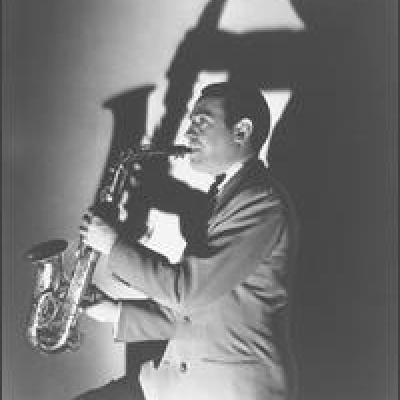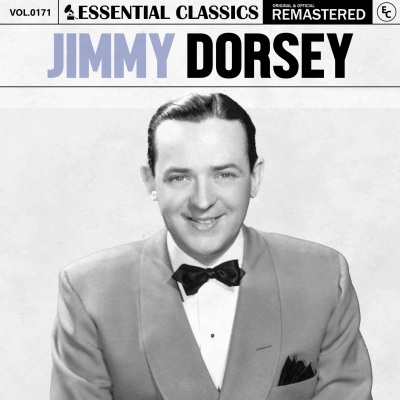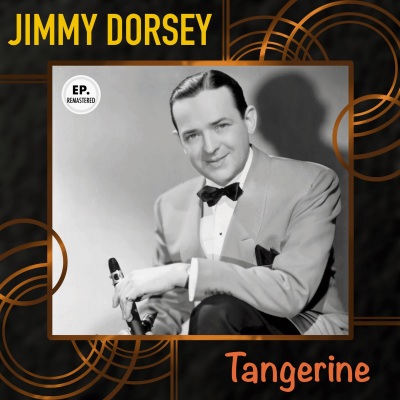
Jimmy Dorsey
by William Ruhlmann & Bruce Eder Jimmy Dorsey was both an accomplished reed player, specializing in alto saxophone and clarinet, and one of the top bandleaders of the swing era. In the early and late periods of his career, he co-led bands with his younger brother Tommy; in between, he scored a series of Latin-tinged hits that established his orchestra as one of the most successful recording and performing units of the early 40s. And despite some lean years in the late 40s and the first half of the 50s, he managed to score a major pop hit during the final weeks of his life.The first son of Thomas Francis Dorsey, Sr., a music teacher and marching band director, and Theresa Langton Dorsey, Dorsey received early music instruction from his father; by the age of seven, he was playing cornet in his fathers band. Switching to trumpet, he made his professional debut at nine when he appeared with J. Carson McGees King Trumpeters in New York in September 1913. But two years later, he had switched to reed instruments, alternating on alto saxophone and clarinet. Less than two years younger, his brother Tommy had taken up horn instruments, sometimes playing trumpet but mainly trombone, and the brothers formed Dorseys Novelty Six in 1920. As Dorseys Wild Canaries, they played an extended engagement at a Baltimore amusement park and made their radio debut (in the process becoming one of the very earliest jazz bands to be heard on the airwaves). Dorsey then left to join the Scranton Sirens. Around September 1924, he moved to New York and joined the California Ramblers, switching to the Jean Goldkette Orchestra in 1925 — where he worked alongside the likes of Bix Beiderbecke, Joe Venuti, Eddie Lang, and Frankie Trumbauer — and then to Paul Whitemans orchestra in 1926. His younger brother followed him into each of these bands. Eventually the brothers settled in New York, where they worked as session musicians, appearing on records, on radio, and in the pit bands of Broadway musicals. Beginning in 1927, they began organizing studio-only ensembles dubbed the Dorsey Brothers Orchestra for recordings on OKeh Records, and they first reached the charts in June 1928 with Coquette (vocal by Bill Dutton). Their first Top Ten placing came in the spring of 1929 with Lets Do It (Lets Fall in Love) (vocal by Bing Crosby). The Dorseys organized a permanent touring band in April 1934 and later signed to the newly formed Decca Records. They reached the Top Ten in the fall with What a Diffrence a Day Made (vocal by Bob Crosby) and in the winter of 1935 with I Believe in Miracles (vocal by Crosby), Tiny Little Fingerprints (vocal by Kay Weber), and Night Wind (vocal by Crosby). Lullaby of Broadway (vocal by Crosby) hit number one in May. Their rise was helped along by their manager, Francis Cork OKeefe, who was one of the prime movers and shakers in the big-band field of the early 30s.By this time, the Dorseys were bidding fair to break out from the pack in the burgeoning field of swing music — and they were poised to do just that when OKeefe booked them into the Glen Island Casino, one of the top big-band venues on the East Coast, complete with a radio hookup from CBS. The brothers had worked together for years at that point, and while their work was frequently dazzling, there were personal tensions that were never far from the surface; the older, more introverted Jimmy was less volatile, while Tommy was more assertive and aggressive. Each knew how to push the requisite buttons in order to needle one another. Theyd gotten into squabbles before — instrument-damaging battles backstage — but on the night of May 30, 1935, on the holiday then known as Decoration Day (now Memorial Day), as the band tried to start Ill Never Say Never Again Again, they got into an dispute over the tempo and Tommy left the bandstand in mid-performance and walked out on his brother and the band. Jimmy was left with the band as it was, and several recordings were still in the pipeline. Ironically, Chasing Shadows (vocal by Bob Eberly) hit number one in June, while Every Little Movement entered the charts in July and reached the Top Ten. Despite his brothers departure, Jimmy Dorsey at first continued to record as the Dorsey Brothers Orchestra, and he scored two Top Ten hits in the fall of 1935, You Are My Lucky Star and Ive Got a Feelin Youre Foolin. (These and all other Dorsey hits unless otherwise noted featured Bob Eberly on vocals.) By the end of the year, however, with Tommy Dorsey having launched his own band, Jimmy Dorsey changed his groups billing to Jimmy Dorsey & His Orchestra, scoring his first chart entry under that name with You Let Me Down in December. The same month, Dorsey signed on to provide the musical accompaniment for host Bing Crosby on the weekly radio series Kraft Music Hall, remaining with the show until July 1937. By squabbling, the Dorseys had lost crucial momentum in their careers; while they sorted themselves out, Benny Goodman emerged and claimed the title of the King of Swing. Tommy Dorsey quickly put together a highly commercial outfit and gave Goodman serious competition. Jimmy Dorsey was not as successful at first, though he topped the charts in June 1936 with Is It True What They Say About Dixie? It was only after he left the Crosby radio show and began appearing extensively on his own that he started to figure among the more popular bands. In 1938, he scored seven Top Ten hits, culminating in Change Partners, which hit number one in October. He had six Top Ten hits in 1939 and three in 1940, including the chart-topper The Breeze and I, which was a key hit, since it began a series of adaptations of Spanish songs arranged by Tutti Camerata. Even as he began to find commercial success, his younger brother was burning up the airwaves with his more commercial brand of big-band music, its appeal spearheaded by the presence of a young singer named Frank Sinatra. Jimmy Dorseys career really took off in 1941 when he scored 12 Top Ten hits. I Hear a Rhapsody reached number one in April, followed by High on a Windy Hill the same month. Another key hit was Dorseys third consecutive chart-topper, Amapola, with alternate verses sung by Bob Eberly and Helen OConnell, which hit number one in March and was the most popular record of the year. Before 1941 was over, Dorsey had returned to number one with My Sister and I, Green Eyes (another duet between Eberly and OConnell), Maria Elena, and Blue Champagne, and he ranked second only to Glenn Miller as the most successful recording artist of the year. Hollywood took an interest in him, and he made his film debut in Lady, Be Good in September 1941. The recording ban called by the American Federation of Musicians in August 1942 cut down on Dorseys recording opportunities, but he still managed to score six Top Ten hits during the year, among them Tangerine, another Latin-tinged number with duet vocals by Eberly and OConnell, which was featured in his second film, The Fleets In, released in March. Overall, he ranked as the fourth biggest recording artist of the year behind Miller, Harry James, and Kay Kyser. The year 1943 was more of a struggle, but Decca settled with the union a year ahead of its rivals, Columbia and RCA Victor, and so its artists, Dorsey among them, were able to dominate the charts in 1944. Dorsey scored five Top Ten hits, among them the chart-topper Besame Mucho (vocals by Eberly and Kitty Kallen), ranking as the third most successful recording artist of the year behind Decca labelmates Bing Crosby and the Andrews Sisters. Amid that string of vocal hits, its easy to forget that the Jimmy Dorsey Band was also a serious jazz outfit, whose members liked to stretch out when they could and just play, and leave the vocalists on the sidelines. The instrumental Contrasts, which dated from 1932, was his signature tune and a perfectly respectable jazz piece, and they also saw some success with the lighthearted pop-jazz piece John Silver, and stretched the envelope with a surprisingly modern electric guitar sound (among other attributes) on Sorghum Switch in 1942. One of the difficulties modern collectors have in understanding Jimmy Dorseys range is that hardly any of his instrumentals have ever seen reissue on LP or, more recently, on CD; the emphasis of the reissues on Dorseys pop hits gives a somewhat inaccurate portrayal of what kind of a band it was, or the level of virtuosity he commanded on the alto sax or the clarinet (on which he was rated in the same league with Benny Goodman and Artie Shaw). Additionally, unlike his brother and many of the other older white jazzmen (and most bandleaders) of the period, Jimmy Dorsey remained just as musically adventurous in the 1940s as he had been in the 1920s and 1930s. He was not only able but willing to incorporate elements of bebop into his work, and his singles of the early 40s were some of the bolder commercial swing sides of the period. He was also unusual as one of the more personally popular bandleaders of the period, among his fellow musicians. In contrast to his younger brother, who had an aggressive streak that intruded on his management style (and caused him to turn on Sinatra when the latter initially announced he was going solo), and to such notable big egos as Glenn Miller and Benny Goodman, Jimmy Dorsey was relatively introspective and retiring, and didnt impose his personality on the players who worked for him. By temperament, he was more a virtuoso musician than a leader, but his band was good enough and his skills in the latter category were sufficient to carry them in one form or another for more than 15 years. The Jimmy Dorsey Band went into a commercial decline from 1945 on, though there were two Top Ten hits in 1945 and one in 1946. By 1947, Dorsey had moved to MGM Records. In May 1947, he participated in a largely fictionalized film biography of himself and his brother, The Fabulous Dorseys, which was notable not just for the work of Jimmy and Tommy but also a musical cameo by Art Tatum. He scored a Top Ten hit with Ballerina (vocal by Bob Carroll) in January 1948 and continued to reach the charts for another couple of years, having moved to Columbia Records by 1950, where he cut some moderately successful (and totally enjoyable) Dixieland-style sides, which also led to the recording of his first LP. But he was forced to disband his orchestra, and in 1953 he accepted an offer from his brother to join the Tommy Dorsey Orchestra as a featured player. Soon, the band was being billed as the Dorsey Brothers Orchestra. From 1954 to 1956, the brothers hosted Stage Show, a live television series. Elvis Presley made his national TV debut on the show in January 1956. Dorsey was diagnosed with throat cancer in 1956. In November 1956, his brother died suddenly, and he took over the band briefly until he was hospitalized in March 1957. His last recording session for Fraternity Records had included So Rare (vocals by the Arthur Malvin Singers), which peaked in the Top Five the week of his death at age 53. Jimmy Dorsey earned a place as a major jazz instrumentalist in the 20s. He backed into bandleading in the 30s, but by the early 40s had built one of the more successful orchestras of the big-band era, with a distinctive style. His hits on Decca (now controlled by the Universal Music Group) are augmented by recordings for Columbia and many small labels, with many of his airchecks also available.





